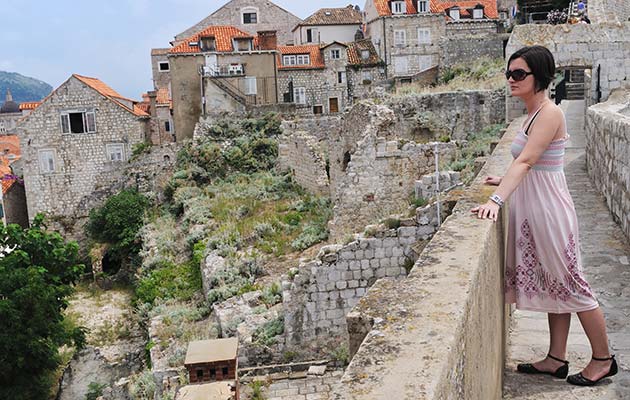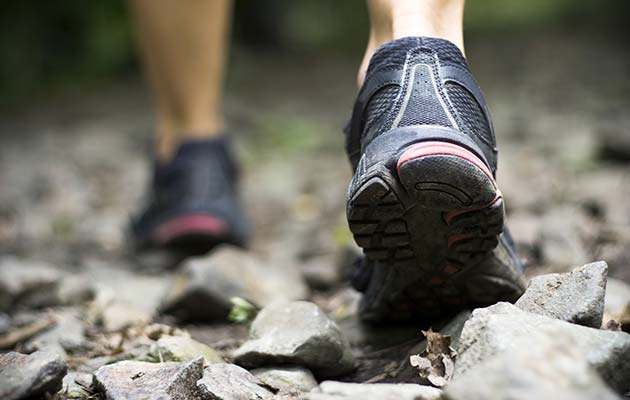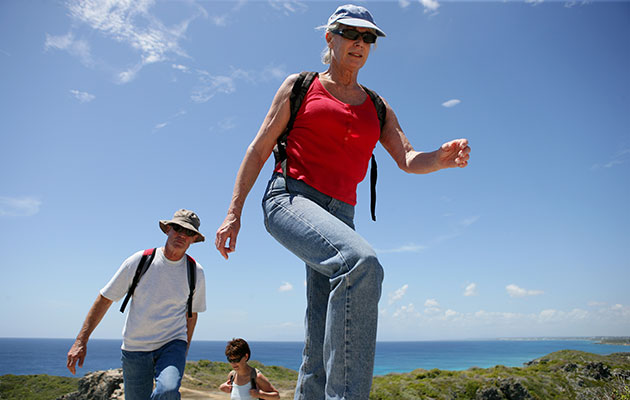Hiking along a glacier in Patagonia, discovering secret side streets in a tiny French village, walking down a rain forest path to a Costa Rican waterfall … some of the world’s most memorable experiences can happen only on foot. Walking is one of the purest pleasures of traveling, offering exercise, fresh air and an intimate perspective on the world.
Urban or rural, easy or challenging, guided or independent — somewhere out there is a walking tour to suit your interests and abilities. We’ll show you the types of walking tours available, the pros and cons of walking independently, and whether a walking vacation is right for you.
For travelers who are reasonably fit and enjoy being out in the open air, walking trips offer a number of benefits. Traveling on foot is the best way to get a close-up look at a local landscape and culture, whether you’re strolling down cobblestone streets or hiking along forest paths. It’s the ultimate in slow travel; you’ll experience each destination at a leisurely pace, getting within a few yards of the local wildlife and examining the architecture up close rather than whizzing by in a car. As with other forms of slow travel, walking is also a great way to lower your environmental impact.
If you tend to pick up a few pounds on every vacation, a walking tour is the perfect antidote. You won’t feel guilty about eating that extra cream puff with your cappuccino at breakfast if you’re climbing the Tuscan hills that afternoon! And unlike other adventure activities such as biking or kayaking, walking is something most travelers can do any time, anywhere, without special training or equipment besides a comfortable pair of shoes.
Walking tours are geared toward a variety of fitness levels, but they aren’t right for everyone. If you can’t walk at a relaxed pace on level ground for at least an hour or two at a time, you may not be physically prepared for a walking tour.
On foot, you may encounter a wide variety of weather conditions, from light rain to extreme heat and humidity. Walking is a more physically demanding experience than riding in a climate-controlled car or bus. Travelers who book a walking tour should be willing to accept some occasional discomfort, including blisters or achy muscles.
Finally, walking is by nature a leisurely style of travel, enabling you to see a limited number of places in an intimate way. Travelers seeking to pack a lot of sightseeing into a small amount of time may be frustrated by the slow pace of a walking trip. If you prefer a faster-paced style of travel, a walking tour may not be right for you.
If you want to make walking a major part of your next trip, there are several ways to do it. The easiest way is to book a trip with a tour operator that specializes in walking vacations. (Several are listed below.) They’ll plan and guide all of your walks, organize lodging and meals, assist in case of injury, and transport your luggage each day so you don’t have to carry it as you walk. Tours are generally led by knowledgeable local guides.
The alternative is to travel independently, either by planning your own walks or by booking individual guided walking tours in each destination that you visit. (Guided walks and city tours are available just about everywhere; to find them, do an Internet search, consult a good guidebook or contact the local tourist office.) Traveling independently allows you a bit more freedom and is usually cheaper than booking a pricey package tour.
If you’re an inexperienced hiker or headed out into an unfamiliar natural environment, we strongly recommend taking a guide, whether it’s someone you hire just for the day or a group leader from a longer package tour.
There are walking vacations to suit nearly every interest and every level of fitness. You can choose an Italian culinary tour that involves easy strolling through small villages, or you can challenge yourself with a week of mountain hiking in the Andes. Accommodations vary widely as well, from camping tents to four-star hotels and luxury inns. Group sizes tend to be on the small size, ranging from 6 to 30 walkers per trip.

The easiest tours blend walking with traditional sightseeing — so you may spend the morning on a country hike and then go shopping, take a cooking class or ride a bus to your next stop in the afternoon. More intense trips may involve walking or hiking steadily throughout the day, or combine walking with other outdoor activities such as kayaking or horseback riding. The most difficult trips are better described as trekking, and typically involve high altitude, rough conditions and specialized equipment. Many companies offer tours in several of these categories, so be sure to read each trip description carefully and choose the appropriate level for you.
Some companies offer special trips for different types of travelers, such as families, women or single travelers. Other tours focus on particular interests, like cooking or history.
Recognizing that some walkers may have different abilities and interests than their traveling companions, some tour operators such as Country Walkers offer multiple options each day — like a moderate hike instead of a difficult one, or a museum visit instead of a walk around the village. Some tours are flexible enough that if you wake up one morning and simply don’t feel up to hiking, you won’t need to.
The most popular destinations for walking trips are Europe and the U.S., but you’ll also find tours in Canada, New Zealand, Costa Rica, Peru, Morocco, South Africa, China, Southeast Asia and beyond.
The cost of a walking tour depends on your destination, the luxury of your accommodations, how many meals are included and other factors. Most tours cost between $300 and $600 per person, per day. This price typically includes accommodations, most meals, guides, transportation of your luggage from one hotel to the next, and most sightseeing and activities. Airfare is usually not included. Other extra costs may include some meals, tips for your guide, add-on activities and tours, and some local expenses.
Prices are almost always based on double occupancy. If you’re traveling solo, you’ll face a single supplement unless you travel on a special tour for singles or your tour operator can find you another solo traveler to room with.
Prepare your body by walking regularly in the weeks before you depart. Try to build up to the kind of walking you’ll be doing during your trip, whether that involves hills, long distances or rough terrain. If you’ll be carrying a day pack on your trip, bring it along as you train to get used to its weight. Most importantly, wear the same shoes you’ll wear for your trip — that way they’ll be well broken in before the big day.
For more strenuous walking trips, you’ll want to improve your overall level of fitness in other ways too, such as weight lifting and cardio training.
If you’re traveling to a mountainous destination, we recommend flying there a day or two early to allow your body to adjust to the altitude. The same goes if you’re traveling through many time zones; walking all day is difficult enough on the body without adding jet lag to the mix.
Finally, consider purchasing travel insurance, particularly if you’ll be hiking in a remote location. This will help protect you in case of injury.

Your tour operator will give you a list of recommended items to pack for your specific itinerary, but here are a few general suggestions:
Comfortable walking shoes — preferably waterproof hiking boots with ankle support (required by some tour operators)
High-quality, waterproof socks
Clothing to suit a variety of weather conditions
Day pack
Camera
Sunscreen
Insect repellent
Sunglasses
Wide-brimmed hat
Walking stick or trekking poles for uneven terrain
For more ideas, see our Interactive Packing List.
Here are several tour operators offering all-inclusive walking vacations:
Backroads: Hiking, walking and multi-sport trips in Europe, Latin America, North America, Asia/Pacific and Africa.
Classic Journeys: Easy-going luxury walking tours in Europe, the Americas, Asia/Pacific, Morocco and Zambia. Trips fall into four categories: cultural walking adventures, culinary tours, family multi-sport trips and private journeys.
Country Walkers: Both guided and self-guided walking trips, including safaris, around the world.
REI Adventures: Hiking, trekking and backpacking trips on every continent except Antarctica. Some trips are appropriate for beginners, while others are quite challenging.
Walking Adventures International: Walking tours around the world, which are generally easy to moderate. Not all tours on the company’s site are offered in any given year.
The Wayfarers: Walking vacations in Europe, New Zealand, Argentina and the U.S. Each vacation is rated by activity level, with many easy and moderate options.











